Wasps Control Melbourne
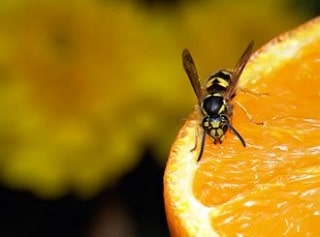
Pest infestations are very common around the world; however, a common type you might spot in Melbourne is the European wasp. Having any sort of infestation nearby your home endangers the protection of your loved ones as well as your pets. Hearing that your child got stung or your dog chased and swallowed a bug, is not news that you would like to hear.
If you notice that the number of wasps you inspected is increasing, there is a chance that there might be a nest around or in your property. To eliminate the risk of getting stung, you need to inspect your home and inspect your business building and treat the infestation to a control and removal service and get a protection system on an urgent basis.
At Protech Pest Control, Melbourne, we provide quick and effective wasp control and removal services and protection systems. We provide same-day wasp control and removal services, pest-free guaranteed services, certified control and removal technicians and control and removal services using Eco-friendly treatments.
Key Facts
- They are found in every continent around the world, except in polar regions.
- The sting is poisonous and can result in swelling. In some cases, it is possible for a person to die due to a sting if they are allergic.
- The stinger is smooth as compared to a bee, that is why they can repeatedly sting, unlike honeybees.
- They emit a pheromone into the air when they die as a signal to warn its fellow mates.
- They can sleep and hibernate for many months while hanging from their teeth.
- They are smaller in size as compared to hornets.
- Only a female can sting and do it repeatedly.
Types of Species Found in Melbourne
1. European Wasp:
- The size of a worker varies between 12-17 mm.
- European wasps are aggressive stinger.
- They have two pairs of clear wings, and the first pair of wings are larger in size.
- The queen can survive over the winter; however, the nest, including the male and females, die during the winter.
2. Yellow Jackets (Social Wasp):
- They can eat other insects as well as human food.
- They can repeatedly sting when provoked.
- Worker is 15 mm long whereas queens are 19 mm long.
- They have 2 pairs of wings and have alternating black and yellow bands.
3. Common Wasp:
- They have 2 black antennae and fly around with their legs close to their body.
- Their size varies from 12 mm to 16 mm.
- They have 2 pairs of wings, and their first pair is larger than the second pair.
- They are known to be aggressive insects.
4. Native Paper Wasp:
- There are 35 different paper species in Australia, including Melbourne.
- Their size varies between 10-22 mm.
- They have a slender body with a very narrow waist.
- They have a small head, but their eyes and antennas are of medium size.
5. Sand Wasp:
- They are 22 mm in size.
- They are usually yellow and black or white and black with bands.
- They feed on nectar but hunt for either flies or any other insect to feed their larvae.
- They are non-aggressive and do not sting if approached; however, if they are needed to defend the nest, they attack in a swarm.
6. Mud Nesting Wasps:
- Their size varies from 5-30 mm.
- Their colour ranges from orange and black to yellow and black.
- They are commonly spotted throughout Melbourne, Australia.
- They live in woodland, forests and urban locations. They feed on the nectar of plants, honeydew and the fluid of the insects that they catch.
7. White-faced Brown Paper Wasp:
- Their size varies between 0.8 to 10 mm.
- They have a white face and brown body with rings in white around the thorax and abdomen.
- They usually nest on overhanging rocks, trees and caves as well as under bridges and homes.
- They are known to be pollinators which make them useful for the environment and beneficial to have in your garden.
8. Tree Brown Paper Wasps:
- Their size varies from 0.8 to 12 mm.
- They have a yellow body with dark brown or black markings on their head, thorax, and abdomen.
- They are commonly found in suburban gardens, forests, and woodlands.
- They usually nest on the sides of buildings and inside hollow trees.
Wasp Nests
The most common types of nests that home-owners and business-owners in Melbourne are infested with are mud daubers, ground nests and paper nests.
- Ground Nests - These types of nests house ground-digging wasps. They are commonly found around homes, and business buildings and the females are known to sting when provoked.
- Paper Nests - The most common type found in Melbourne are European Paper Wasp and Asian Giant Hornet. Their nests are found nearby gutters of homes or business buildings, on the steps of a porch or hanging from a tree branch.
- Mud Daubers - Their nests are made from mud. Mud daubers are typically considered as a nuisance and not as a threat to humans due to being known for rarely stinging people; however, it is still essential to get control and removal services done.
Although there are various 'Do It Yourself' control and removal methods published on the internet to remove nests, it is advisable not to do so yourself as you may lack the knowledge and experience that a professional control and removal expert might possess.
At Protech Pest Control Melbourne, we provide certified technicians that possess the knowledge, treatment, protection systems and experience of care and effectively controlling and removing infestations with our services. Our control and removal services are only conducted after a thorough inspection of the infestation in your home or your office building.
We understand that having a pest infestation in your home or office will lead to bad business and may drive away your potential clients or business partners, which is why we use state-of-the-art equipment, effective Eco-friendly treatments, and protection systems to aid in preventing any further pest infestations and for the protection of your loved ones, employees and clients.
How to Inspect if There is a Nest Nearby?
If you notice that the infestation near your home or office is increasing day by day, then there surely is a nest around your property.
A nest appears like a papery wall due to being made from wood pulp and their saliva. Some common locations to inspect for a nest is in a wall cavity of a building, on the roof of the building, in your home sheds and garages, under the building of your home, in the parking lot of your business building or bird boxes.
If you are unable to spot a nest even after inspecting the building area, you can follow the return path of a wasp and see where it goes, it will ultimately lead you to the nest. It is easier to inspect for a nest in the summer or spring due to the increasing number as well as because they die during the winter.
The size of the nest inspected can be as small as a golf ball and as big as a football or even better. It is recommended that you treat a nest to a control and removal service and get a protection system as soon as you notice it before they increase in number and before they become aggressive.
Wasp Nest Control and Removal in Melbourne
Trying to remove a nest or inspecting for a nest on your own is very dangerous as the wasps inside will feel threatened and might attack by stinging you or your loved one.
To avoid such a situation, it is necessary to get a professional wasp nest control and removal expert to treat the nest and to install a protection system. To eliminate the nest, you need not remove it but rather treat the nest with treatment and install a protection system. This treatment and technique are known to our professional nest extractors, and they can help solve your pest problem in a way that prevents the return of any pest.
At Protech Pest Control Melbourne, our control and removal technicians have special protection equipment for protection against stings during any infestation removal service. After inspecting the type of species, our experts will use the customised control and removal service for that particular species for better results. All these treatments and protection systems are customised based on the location of the nest to ensure efficient control and removal.
How to Prevent Wasp?
The best way to prevent them is by getting a nest control and removal service and a protection system as soon as possible. Doing so, you avoid any chances of getting stung. Another way to prevent these insects is by making a few changes to your lifestyle, such as the way you handle food and drinks outside your home.
- Make sure that your garbage bins are securely fitted, preventing access for pests. Keep your garbage at a distance from your home window and doors to prevent it from attracting insects.
- Keep doors, and windows shut or use mesh barriers to avoid insects from entering.
- Once you have inspected and found a nest nearby, ensure you keep your family members and pets away from the area.
- Regularly check for nests at the beginning of summer to prevent the increase of an infestation.
Know How to Get Rid of Nests the Right Way
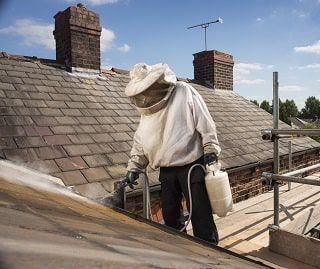 While trying to eliminate a nest, most people tend to use methods such as burning it, flooding it with water or hitting it with a baseball bat. It is essential for you to note that using such methods will not eradicate the infestation, but instead, it will increase the chances of you getting attacked and stung by wasps as well as the chances of harming your building property. There are also chances of you getting stung before you even begin attacking it with a baseball bat.
While trying to eliminate a nest, most people tend to use methods such as burning it, flooding it with water or hitting it with a baseball bat. It is essential for you to note that using such methods will not eradicate the infestation, but instead, it will increase the chances of you getting attacked and stung by wasps as well as the chances of harming your building property. There are also chances of you getting stung before you even begin attacking it with a baseball bat.
Due to all these reasons, to safeguard your family and your property, it is essential to hire a control and removal expert to carry out an effective control and removal treatment service. The reason behind the success of the removal service is;
The technician has access to protective gear and a piece of respiratory protection equipment which aids in securing and protecting them from any sting while inspecting your building.
The technician has experience of working in small spaces such as your attic or under your home building, allowing them to examine and treat the nest with the service adequately.
Our technicians have exclusive access to and are trained in using our variety of Eco-friendly protection systems and effective control and removal treatment products for the services which are known for making the service a success.
Our technicians possess the right knowledge on a variety of species, how to accurately inspect the building, how to effectively conduct the service, how to inspect an allergic reaction to a sting and the behaviour of different species, which enables them to choose the right control and removal treatment service.
How to Avoid Getting Stung?
You can avoid getting stung by following these rules:
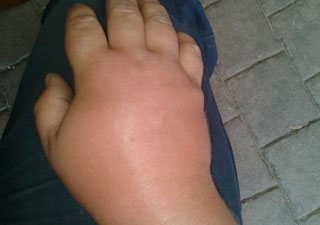
- While inspecting if there is a wasp near you, do not panic, instead, keep calm and move away slowly.
- Screaming, flapping your arms around or trying to swat them will agitate and make them aggressive towards you.
- Do not use strong or sweet-smelling hairsprays, perfumes, or shampoos.
- Avoid wearing floral patterned clothes/ bags as well as any bright coloured garment as it could attract them to you.
- Secure the bins at your business building and avoid having any soft fruit plants lying around your home or building as it could attract hungry insects.
- Avoid drinking outdoors or leaving your opened drinks unattended as an insect could crawl inside.
- Make sure your children's hands and body are clean from any residue of food or drinks as it could attract insects.
- Always keep your food and drinks covered when you are outdoors.
How to Treat a Sting?
You can treat a sting by first scraping off the stinger that is the surface of the skin with the edge of a credit card. Cleaning the area with warm water and soap. You could also apply and remove an icepack with a 10-minute interval for an hour or take a painkiller or antihistamine to reduce the pain or reduce the swelling.
Another way to treat a sting is by either applying a soaked cotton ball of apple cider vinegar or lemon juice to your sting or by applying a slice of lemon to your sting.
Why should You Choose Protech Pest Control For Wasp Control in Melbourne?
At Protech Pest Control Melbourne, we provide our clients with a free quotation, certified wasp control and removal service technicians, same-day control and removal services, effective control and removal treatment services using Eco-friendly treatments for various type of pests, protection systems for your home and business buildings and provide a pest-free guarantee service.
Get in touch with us for a thorough inspection of your home by calling us at 1300 486 149
Frequently Asked Questions
-
What type of wasps are most likely to settle in my Melbourne home?
The most common type of wasp that residents in Melbourne spot are the European Wasps that are known to get aggressive when they feel threatened. It is important to not attack or come near their nests as they could sting you or your loved one.
-
What are they attracted to?
They are attracted to floral patterns, bright colours, strong sweet smells, convenient water and food sources, and any location that suits best for breeding.
-
How many wasps can live in a nest?
Depending on the time of the year, the size of the nest may vary. However, on a perfect summer day, you can expect about 3,000 to 6,000 wasps present in a nest. It necessary to inspect for any infestation regularly and to avoid the risk of getting stung, it is advisable to treat an infestation with a control and removal treatment service as soon as you notice it.
-
What is the difference between a wasp and hornet?
The difference between a wasp and hornet is the size and color, a hornet is larger and is black and white, whereas a wasp is smaller and is black and yellow in color.
-
What do you do if you find a nest?
If you find a nest or inspect an infestation, ensure you contact a wasp control and removal expert for an infestation removal service as soon as possible and keep your loved ones and pets away from the infested area or building unless the infestation is treated.
-
I see a number of wasps around, but I can't find their nest. What should I do?
For this very reason, it is crucial to contact pest control and removal expert and get an infestation removal service done. The reason could either be that the infested nest is within your neighbour's property, however, the wasps are entering your building due to being attracted to the open food and water source in your home or maybe because of the 'lost wasp syndrome' where a young wasp is roaming around your building looking for the nest that is at your neighbours home but can't find it due to your home resembling your neighbours home.
-
I am afraid that the nest I need to be removed is very large, can you still help?
Nests bigger than 50 cm x 50 cm require a professional wasp control and removal treatment service because the approach and treatment service vary based on the type of species as well as the size of the infestations. Bigger nests mean bigger infestations which is why it is essential to treat the infestation to a control and removal treatment service as soon as you inspect one, even if it is as small as a golf ball.
Client Testimonials
I had wasps flying around in the back yard I called a company which told me it was a season for them and not to worry. This over the next 2 weeks wasp numbers increased tripled so I decided to call another pest control company which was Protech Pest Control, they sent a tech out and he spent a half an hour inspecting around the house and found where the wasps were entering and exiting my home. It turned out to be a massive nest growing in the roof of my home which was the size of 1 and a half basketballs they proceeded to spray and dispose of the nest and now I am wasp free. I would recommend protech to others and have already to relations with the same problem which also have praised them.
- Sandra Boicos
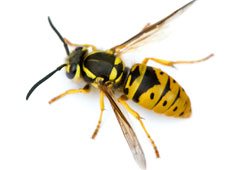
Wasp Isolated
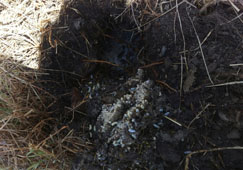
Wasp Nest in Farm